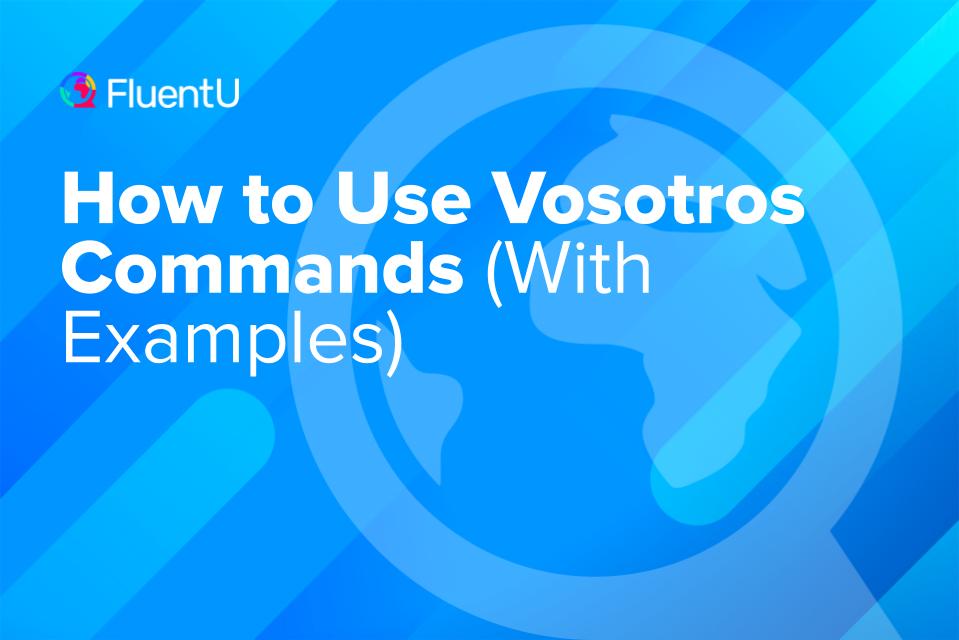How to Use Vosotros Commands (With Examples)

¡Escuchad, prestad atención! (Listen, pay attention!). Do these words seem unfamiliar or strange to you? If you learned Spanish in the Americas, it’s likely that they do, since those commands are in the vosotros form. The vosotros form is the informal, second-person plural form (“you all”) and it’s used exclusively in Spain.
In this post, we’ll tell you everything you need to know about forming commands in the vosotros form.
Download: This blog post is available as a convenient and portable PDF that you can take anywhere. Click here to get a copy. (Download)
What is Vosotros?
I like to think of vosotros as the Spanish equivalent of “you guys” or “y’all.” In other words, use it in Spain to mean “you” when referring to multiple people in an informal situation. For example:
¿Vais a la fiesta de Pablo? (Are you guys going to Pablo’s party?)
If you learned Latin American Spanish, you’ll probably be accustomed to using the ustedes form to refer to any group of more than one person, whether formal or informal.
In comparison with many Latin American countries, Spaniards tend to use informal conjugations (tú and vosotros) much more frequently and reserve ustedes exclusively for very formal situations, such as a job interview.
When to Use Vosotros Commands
Now that we’ve gone through when to use vosotros, let’s talk about when to use vosotros commands.
Use a vosotros command whenever you want to direct or command a group of more than one person. For example:
¡Sacad vuestros libros, por favor! (Take out your books, please!)
Commands are useful for expressing authority, however they can also be polite or friendly. The command form can be used to suggest.
For example, when speaking to your friends, you could use the command form to say:
¡Venid a la fiesta! (Come to the party!)
¡Pasadlo bien! (Have a good time!)
¡Contadme lo que os pasó anoche! (Tell me what happened to you guys last night!)
In these cases, the commands aren’t really demanding anything—they’re just a way of expressing a suggestion, hope or desire.
How to Form Vosotros Commands
In Spanish, you conjugate commands differently based on whether you’re making a positive or negative command.
A positive command is when you tell someone to do something. “Go away,” “Let’s go to the movies,” and “Sit down, please” are all examples of positive commands.
On the other hand, you use a negative command when you tell someone not to do something. “Don’t eat that,” “Don’t worry” and “Don’t go” are all examples of negative commands.
In this section, we’ll learn how to conjugate positive and negative vosotros commands.
Positive Vosotros Commands
Forming the positive vosotros command is one of the easiest Spanish conjugation rules you’ll ever have to learn:
Simply take any infinitive verb, drop the final r and add a d.
For example, the infinitive hablar (to speak) becomes the command ¡hablad! (speak!).
There isn’t a single irregular conjugation for vosotros commands.
Here are some examples of positive vosotros commands:
¡Mirad la televisión! (Look at the television!)
¡Venid a cenar! (Come to have dinner!)
¡Bebed agua! (Drink water!)
Negative Vosotros Commands
Much like negative tú, usted and ustedes commands, negative vosotros commands require the use of the Spanish subjunctive mood.
For negative commands, -ar, -er and -ir verbs have slightly different rules:
For -ar verbs, to form a negative command you drop the -ar ending and add -éis:
¡No habléis así! (Don’t speak like that!)
For –er and –ir verbs, to form a negative command you drop the ending and add -áis:
¡No vendáis la casa! (Don’t sell the house!)
¡No subáis al autobús! (Don’t get on the bus!)
With negative commands, you’ll have to deal with the same stem-changing verbs and irregular forms as you do with the subjunctive. However, if you learn the vosotros subjunctive you’ll immediately know the negative commands, and vice versa!
Here are a few more examples to get you more used to this form:
¡No vengáis nunca más a mi casa! (Don’t ever come to my house again.)
¡No tengáis miedo! (Don’t be afraid!)
¡No lleguéis tarde! (Don’t arrive late!)
With practice, you’ll quickly master negative vosotros commands. In the meantime, this handy Spanish verb conjugation tool is an absolute life-saver.
Adding Pronouns to Vosotros Commands
Direct or Indirect Object Pronouns
When forming commands in the vosotros form, you’ll occasionally want to add direct or indirect object pronouns to the command.
In a positive vosotros command, add the object pronoun directly to the end of the word:
¡Hacedlo! (Do it!)
¡Escuchadme! (Listen to me!)
Tenedlo en mente. (Keep it in mind.)
With negative commands, on the other hand, the object pronoun goes between the word “no” and the verb:
¡No lo hagáis! (Don’t do it!)
¡No me digáis eso! (Don’t tell me that!)
¡No la compréis! (Don’t buy it!)
Reflexive Pronouns
If you’re conjugating reflexive verbs in the vosotros form, you’ll want to use the reflexive pronoun os.
Similar to direct and indirect object pronouns, the reflexive pronoun os is placed at the end of positive commands. However, when adding the pronoun os, you remove the final d of the positive command.
¡Callaos! (Be quiet!)
¡Lavaos las manos! (Wash your hands!)
When conjugating an -ir verb like this, you need to add an accent mark:
¡Decidíos! (Make up your minds!)
There’s only one irregular conjugation to worry about: The verb irse (to leave) retains its final d and becomes ¡idos! (Leave!).
This is the grammatically correct way to conjugate positive commands. However, you may notice that there are certain colloquial variations that are widely used and accepted in Spain.
Some speakers will keep the final d attached to the command, saying something like ¡Sentados! (Sit down!) instead of sentaos.
Other times, you’ll see people replace that final d with an r when adding the pronoun os. For example, ¡Veniros! (Come here!) instead of veníos.
Both conjugations are technically “incorrect,” but very common in colloquial speech.
When it comes to reflexive pronouns, negative commands are much simpler. Much like object pronouns, the os simply comes between the word “no” and the verb:
¡No os caséis! (Don’t marry each other!)
¡No os mováis! (Don’t move!)
Using Media to Learn Vosotros Commands
The best way to learn the vosotros commands is to consume native media and see how they are used by native speakers.
Books and TV shows can be good ways to learn when and how to use vosotros commands. Just make sure the media you choose comes from Spain, since you won’t hear vosotros in most programs from Latin America.
For example, you could get the Castilian Spanish translation of “Harry Potter.” You could also find a Spanish program on Netflix like “La casa de papel” (“Money Heist”) or change the language on Netflix to “European Spanish” and listen to the dubbed version of your favorite movie.
For a little extra learning support, you could opt for a language learning program like FluentU.
FluentU takes authentic videos—like music videos, movie trailers, news and inspiring talks—and turns them into personalized language learning lessons.
You can try FluentU for free for 2 weeks. Check out the website or download the iOS app or Android app.
P.S. If you decide to sign up now, you can take advantage of our current sale!

There’s also the FluentU Spanish YouTube channel, which has tons of videos that use Spanish-dubbed episode clips of popular movies and TV shows to give you in-depth lessons. For example, here’s a video that uses Shrek to teach meaningful vocabulary, grammar, expressions and cultural context:
And here’s one from “Stranger Things,” if that’s more your style:
By consuming native media, you’ll be able to see how vosotros commands are used in context and you’ll soon become confident in using them.
When it comes to vosotros commands, ¡no tengáis miedo, chicos! (Don’t be afraid, guys!)
This conjugation form might seem unfamiliar if you’re accustomed to Latin American Spanish but you can still master it!
Estudiad (study) and you’ll be a pro at vosotros commands in no time at all.
Download: This blog post is available as a convenient and portable PDF that you can take anywhere. Click here to get a copy. (Download)
And One More Thing…
If you've made it this far that means you probably enjoy learning Spanish with engaging material and will then love FluentU.
Other sites use scripted content. FluentU uses a natural approach that helps you ease into the Spanish language and culture over time. You’ll learn Spanish as it’s actually spoken by real people.
FluentU has a wide variety of videos, as you can see here:

FluentU brings native videos within reach with interactive transcripts. You can tap on any word to look it up instantly. Every definition has examples that have been written to help you understand how the word is used. If you see an interesting word you don’t know, you can add it to a vocab list.

Review a complete interactive transcript under the Dialogue tab, and find words and phrases listed under Vocab.

Learn all the vocabulary in any video with FluentU’s robust learning engine. Swipe left or right to see more examples of the word you’re on.

The best part is that FluentU keeps track of the vocabulary that you’re learning, and gives you extra practice with difficult words. It'll even remind you when it’s time to review what you’ve learned. Every learner has a truly personalized experience, even if they’re learning with the same video.
Start using the FluentU website on your computer or tablet or, better yet, download the FluentU app from the iTunes or Google Play store. Click here to take advantage of our current sale! (Expires at the end of this month.)







